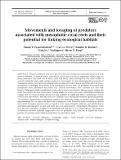Movements and foraging of predators associated with mesophotic coral reefs and their potential for linking ecological habitats
Abstract
Marine predators will often perform diel and seasonal movements associated with specific habitats. In tropical areas, mesophotic coral reefs may be an important habitat type for many predators but their use of these areas has rarely been investigated. We used results of acoustic telemetry and stable isotope analyses to investigate the diel and seasonal movements of Galapagos sharks Carcharhinus galapagensis and giant trevally Caranx ignobilis captured from a mesophotic reef (depth: 50–70 m) at an uninhabited Pacific atoll. All predators performed horizontal and vertical movements over seasonal and diel time frames associated with mesophotic reefs. Galapagos sharks performed reverse diel vertical movements diving deeper during the night than during the day, while giant trevally displayed a mix, with some individuals performing regular diel movements (deep during the day, shallow at night) while others performed reverse vertical diel movements. Trevally used very shallow water during the spawning periods in the summer. The isotopic compositions of predators suggest they primarily forage in shallow reefs, although approximately 35% of resources came from mesophotic reefs. Similar to variability in vertical movement strategies, giant trevally occupied a wide range of trophic positions, potentially due to individual specialization in diet and high levels of intra-specific competition. Mesophotic reefs provide some prey to upper level predators but may primarily serve as a refuge habitat. The frequent movements between habitats suggest that marine predators may function as significant transporters of nutrients from shallow to mesophotic reefs.
Citation
Papastamatiou , Y , Meyer , C G , Kosaki , R K , Wallsgrove , N J & Popp , B N 2015 , ' Movements and foraging of predators associated with mesophotic coral reefs and their potential for linking ecological habitats ' , Marine Ecology Progress Series , vol. 521 , pp. 155-170 . https://doi.org/10.3354/meps11110
Publication
Marine Ecology Progress Series
Status
Peer reviewed
ISSN
0171-8630Type
Journal article
Collections
Items in the St Andrews Research Repository are protected by copyright, with all rights reserved, unless otherwise indicated.

